Introduction
Up to now, among the various herbs available, A. vera is the most popular and is receiving a lot of scientific attention [1]. In general, Aloe belongs to Asphodelaceae (Liliaceae) family, and is a semitropical, shrubby, or arborescent, perennial, xerophytic, succulent, pea-green color plant [2]. It is known that there are over 400 species in the genus Aloe [3]. However, among them, A. vera, Aloe ferox, and Aloe arborescens are traded worldwide [3]. Aloe barbadensis Miller is commonly referred to as A. vera [2,3]. Especially, the Aloe plant is very sensitive to temperature, so it is now grown on a large scale in warm tropical regions [1,3]. The main characteristic of A. vera plants is that the solid material is about 0.5%–1.0%, but the water content is about 99–99.5% [3].
As is known so far, it has been found that the biological benefits associated with A. vera are due to the polysaccharides contained in the leaf’s gel [1,3,4]. Currently, gel, also called transparent pulp, is widely used in cosmetic, medical, and food fields [4,5]. Especially, since A. vera has various medicinal properties, many studies are being conducted centered on A. vera [1,3-5]. The various biological and pharmacological functions of A. vera gel are summarized in Fig. 1.
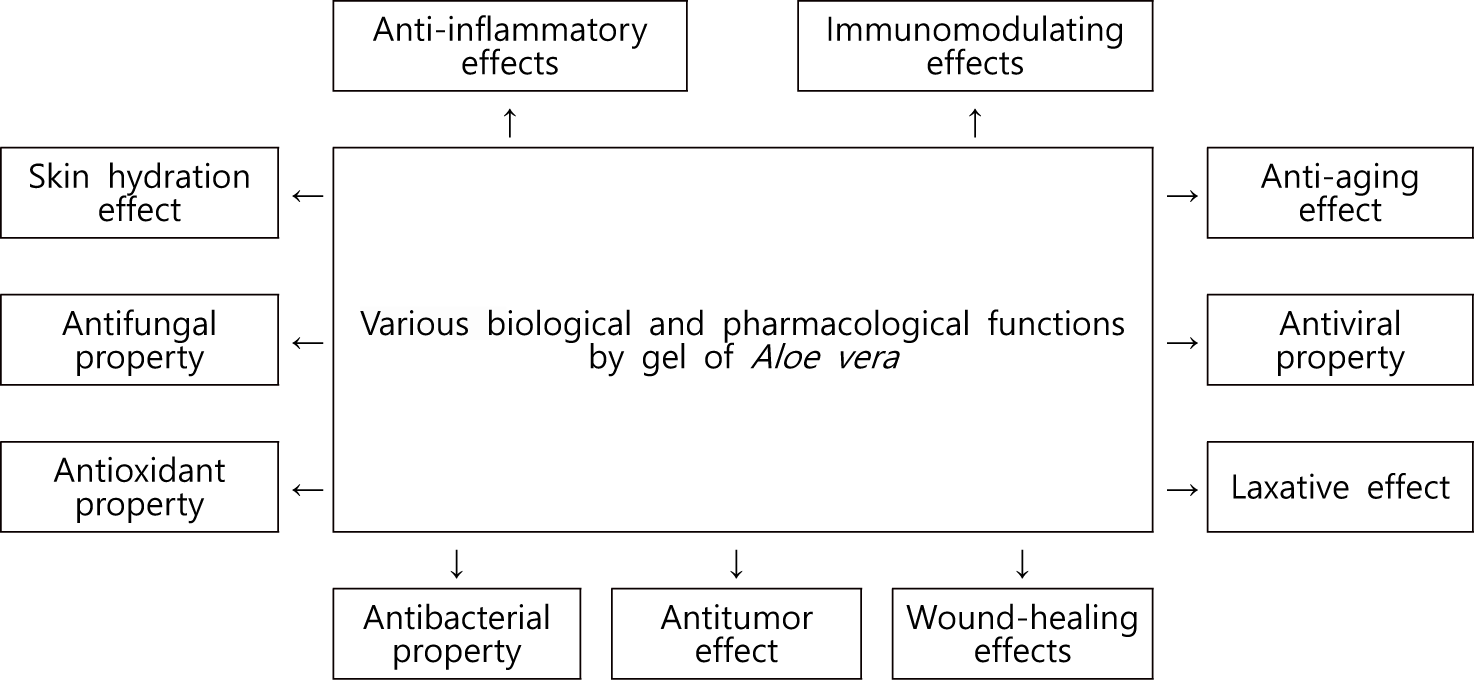
Furthermore, it has been reported that more than 75 potentially active compounds such as enzymes, fat- and water-soluble vitamins, minerals, organic acids, simple/complex polysaccharides, phenolic compounds are contained in the solid material of A. vera [3,6]. But, during processing and storage, the physical stability mechanisms and rheological behavior of suspensions are greatly affected. This phenomenon occurs because both aloe gel and pulp contained large amounts of insoluble polymer particles. [7]. Therefore, continuous research is needed to solve these problems mentioned above. Then it can be used more actively in the food industry.
Next, A. vera is also known as a useful secondary metabolite [8,9]. The main secondary metabolites are anthraquinones and tricyclic aromatic quinines, which are abundantly present [3]. Aloe emodin and chrysophanol are the main components of natural anthraquinone derivatives [10]. It is known that the tricyclic aromatic quinine of Aloe is synthesized through the type III polyketide biosynthetic pathway [3]. In other words, aloesin, aloin and aloe-emodin (oxidation products of aloin) are the most important secondary metabolites found in gel of A. vera [3]. In addition, it is reported that the physiological activity of many secondary metabolites of plants has strong anti-inflammatory, antioxidant activity, lipid-lowering, and so on [11-13]. It has even been approved by the US Food and Drug Administration (FDA) for development research in the treatment of cancer and AIDS using A. vera [3].
Therefore, the method of fortifying aloe oil containing various functional substances directly to nondairy or dairy products is recommended. In this way, the functional substances of aloe oil in food can be further activated, which can enhance human health benefits and upgrade the sensory quality. However, studies on the estimation of sensory quality after direct application of aloe oil to various nondairy or dairy products are lacking.
Subsequently, the purpose of this study is to estimate the sensory quality by fortifying aloe oil of diverse concentrations to soy milk, cow milk, yoghurt, and Kefir, respectively.
Materials and Methods
The aloe oil used in this study was purchased from 100% Live Natural Aloe Oil (30 mL) manufactured by Hermani General Trading LLC (UAE), and also was approved as a food additive.
Aloe oil was fortified to nondairy product (soy milk) and dairy products (cow milk, yogurt, Kefir) at diverse concentrations (fortified by adding 1% increments from 0% up to 5%). Then, samples of soy milk, cow milk, yogurt, and Kefir fortified with aloe oil were kept at 7±2°C until estimation. All samples were purchased from a supermarket located east of Seoul, and a description of the samples used in this study was as follows. Null-Additive Soybean Milk produced by Hanmi Healthcare (Korea) was used as a sample of soy milk, Konkuk Milk produced by Konkuk Dairy & Ham was used as a sample of cow milk, Yoplait Only 2 Plain produced by Binggrae (Korea) was used as a sample of yoghurt, and Kefir 12 Plain produced by Maeil Dairies (Korea) was used as a sample of Kefir.
The score of pH of nondairy product (soy milk) and dairy products (cow milk, yogurt, Kefir) fortified with aloe oil at diverse concentrations were estimated by the Thermo ScientificTM OrionTM Star A211 pH Benchtop Meter (Thermo Fisher Scientific, USA).
Nondairy product (soy milk) and dairy products (milk, yogurt, Kefir) with diverse concentrations of aloe oil fortified were prepared and kept at 7±2°C until estimation. The panel of seven well-trained researchers estimated the sensory quality of soy milk, cow milk, yogurt, and Kefir fortified with diverse concentrations of aloe oil. All samples in this study were randomly estimated in single-use plastic cups (30 mL) at 10°C. The category of sensory quality of all samples estimated in this study included texture, color, taste, and overall acceptability, and were estimated on a scale of 1 (very bad) to 5 (excellent) based on the 5-point hedonistic score. And 2, 3, and 4 mean bad, average, and good, respectively.
Results and Discussion
The score of pH of aloe oil was approximately 1.7 (data not shown), and then the score of pH of soy milk, cow milk, yoghurt, and Kefir without fortified with aloe oil was 6.69, 4.17, 4.15, and 6.73, respectively (Fig. 2). The score of pH of soy milk, cow milk, yoghurt, and Kefir fortified with diverse concentrations (fortified by adding 1% increments from 0% up to 5%) of aloe oil exhibited similar to that of soy milk cow milk, yoghurt, and Kefir with no addition of aloe oil in this study (Fig. 2). Hence, no statistically significant difference was observed between the treated group and the control group in the score of pH.
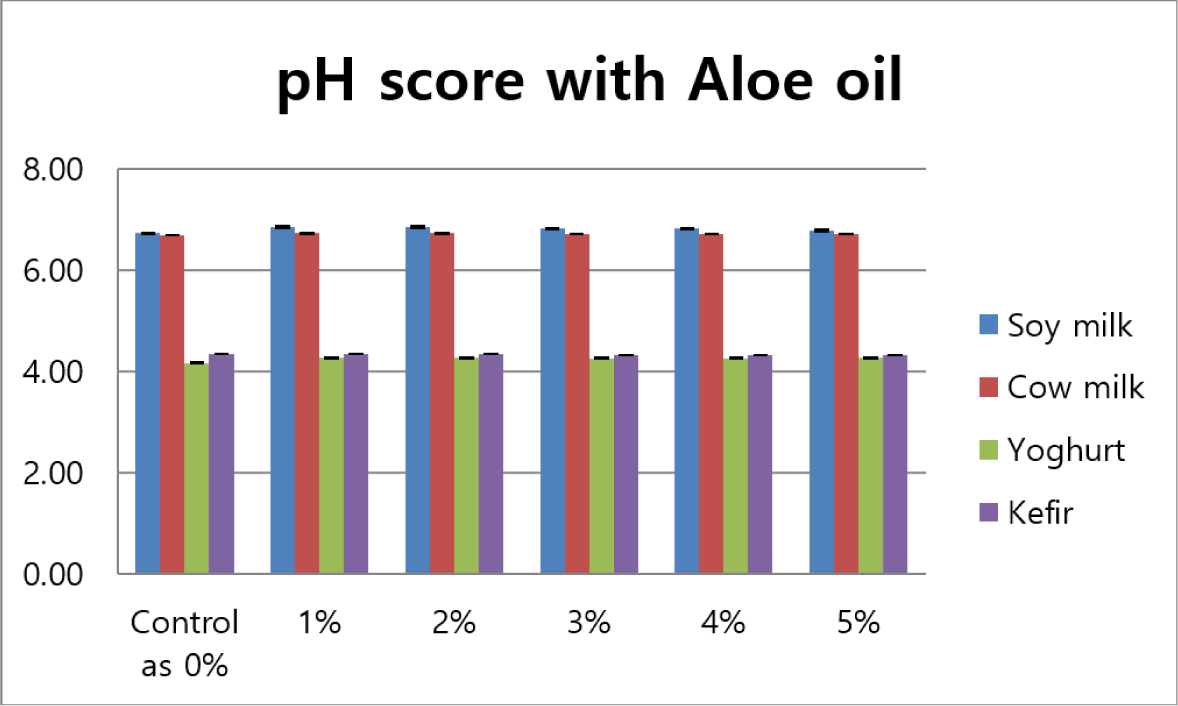
There was no statistically significant difference in the results of previous researches that studied the outline in pH score when vegetable oil was fortified to dairy or food products [14,15]. Also, the results of the outline in pH score in this study also showed a similar trend.
Fig. 3 exhibited the outline of sensory quality of soy milk estimated by seven panels. Soy milk was fortified with diverse concentrations (fortified by adding 1% increments from 0% up to 5%) of aloe oil. When aloe oil was fortified to soy milk from 1% to 5%, the score of texture varied from 4.8 to 4.5, the score of color varied from 3.7 to 1.3, the score of flavor varied from 3.3 to 1.2, and the score of overall acceptability varied from 2.8 to 1.2, which was lower than 5 of the control group (Fig. 3).
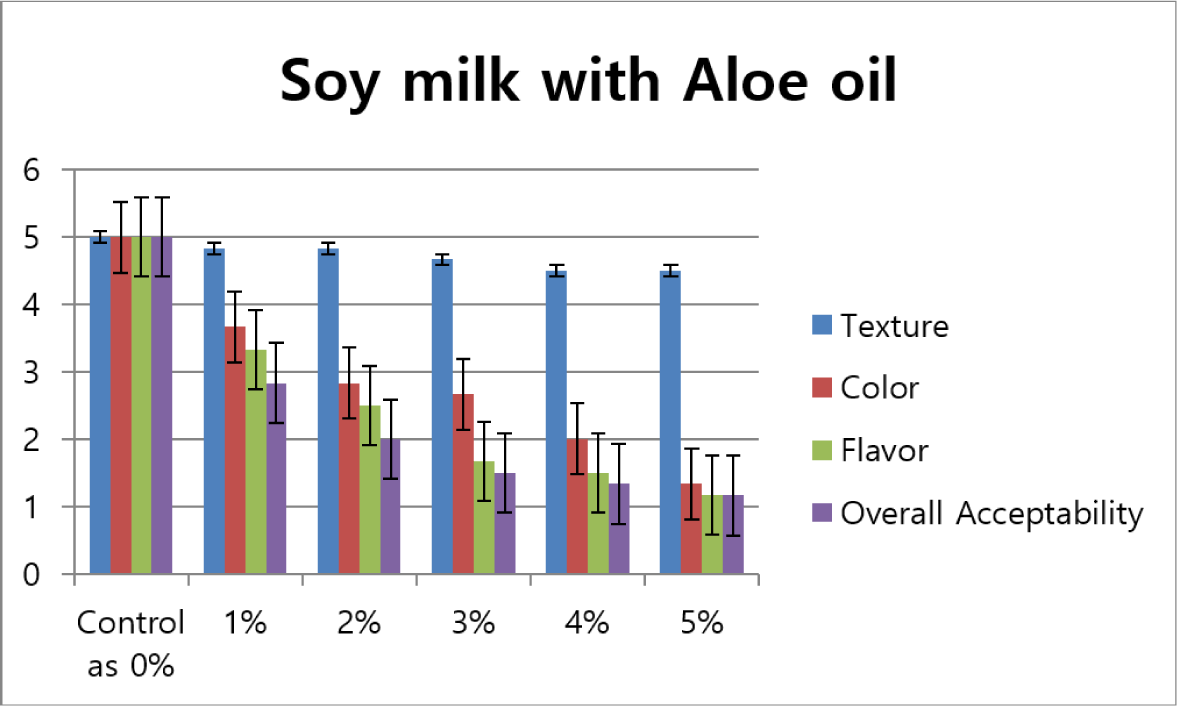
Based on the statistical estimation of the sensory quality of soy milk obtained in this study, the statistically significant difference was observed between the treated group and the control group in texture, color, flavor, and overall acceptability (p<0.05). When the addition amount of aloe oil was increased, the score of sensory quality of texture, color, flavor, and overall acceptability tended to decrease (Fig. 3). In this study, the soy milk fortified with 1% of aloe oil exhibited the best results compared with control group.
Fig. 4 exhibited the outline of sensory quality of cow milk estimated by seven panels. Cow milk was fortified with diverse concentrations (fortified by adding 1% increments from 0% up to 5%) of aloe oil. When aloe oil was added to cow milk from 1% to 5%, the score of texture varied from 4.8 to 4.0, the score of color varied from 2.8 to 1.05, the score of flavor varied from 2.2 to 1.0, and the score of overall acceptability varied from 1.8 to 1.0, which was generally lower than 5.0 of the control group (Fig. 4).
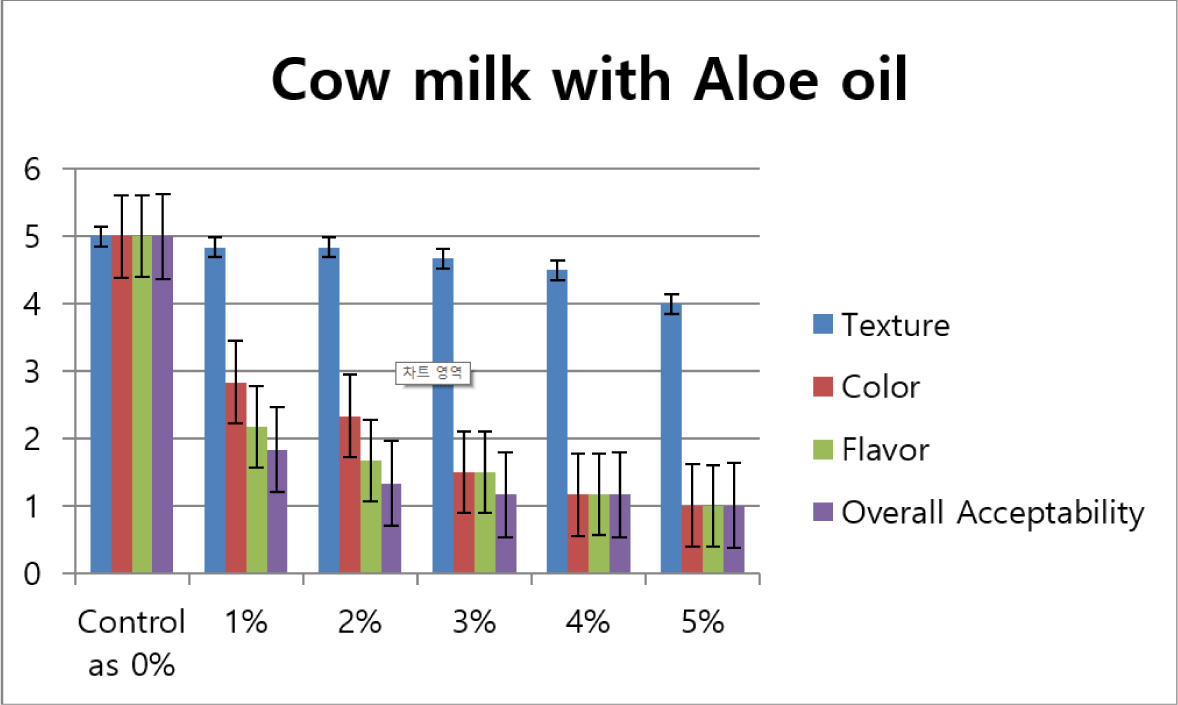
Based on the statistical estimation of the sensory quality of cow milk obtained in this study, the statistically significant difference was observed between the treated group and the control group in texture, color, flavor, and overall acceptability (p<0.05). When the addition amount of aloe oil was increased, the score of sensory quality of texture, color, flavor, and overall acceptability tended to decrease (Fig. 4). In this study, the cow milk fortified with 1% of aloe oil exhibited the best results compared with control group.
Fig. 5 exhibited the outline of sensory quality of yoghurt estimated by seven panels. Yoghurt was fortified with diverse concentrations (fortified by adding 1% increments from 0% up to 5%) of aloe oil. When aloe oil was fortified to yoghurt from 1% to 5%, the score of texture varied from 5.0 to 4.7, the score of color varied from 4.2 to 3.2, the score of flavor varied from 2.8 to 1.2, and the score of overall acceptability varied from 2.8 to 1.0, which was generally lower than 5.0 of the control group (Fig. 5). But, the score of texture was very similar to that of the control group, and there was no statistically significant difference.
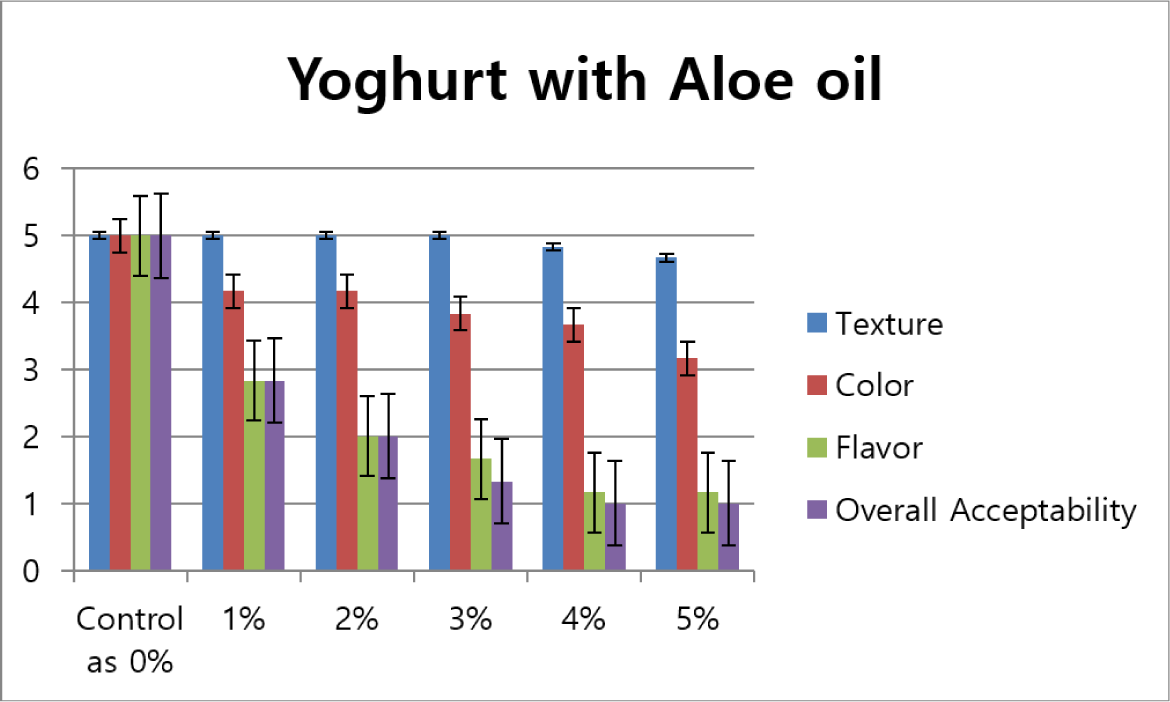
Based on the statistical estimation of the sensory quality of yoghurt obtained in this study, the statistically significant difference was observed between the treated group and the control group in color, flavor, and overall acceptability except texture (p<0.05). When the addition amount of aloe oil was increased, the score of sensory quality of color, flavor, and overall acceptability tended to decrease except texture (Fig. 5). In this study, the yoghurt fortified with 1% of broccoli oil exhibited the best results compared with control group.
Fig. 6 exhibited the outline of sensory quality of Kefir estimated by seven panels. Kefir was fortified with diverse concentrations (fortified by adding 1% increments from 0% up to 5%) of aloe oil. When aloe oil was fortified to kefir from 1% to 5%, the score of texture varied from 5.0 to 4.7, the score of color varied from 4.7 to 2.7, the score of flavor varied from 3.5 to 1.2, and the score of overall acceptability varied from 3.3 to 1.2, which was lower than 5 of the control group (Fig. 6). But, the score of texture was very similar to that of the control group, and there was no statistically significant difference.
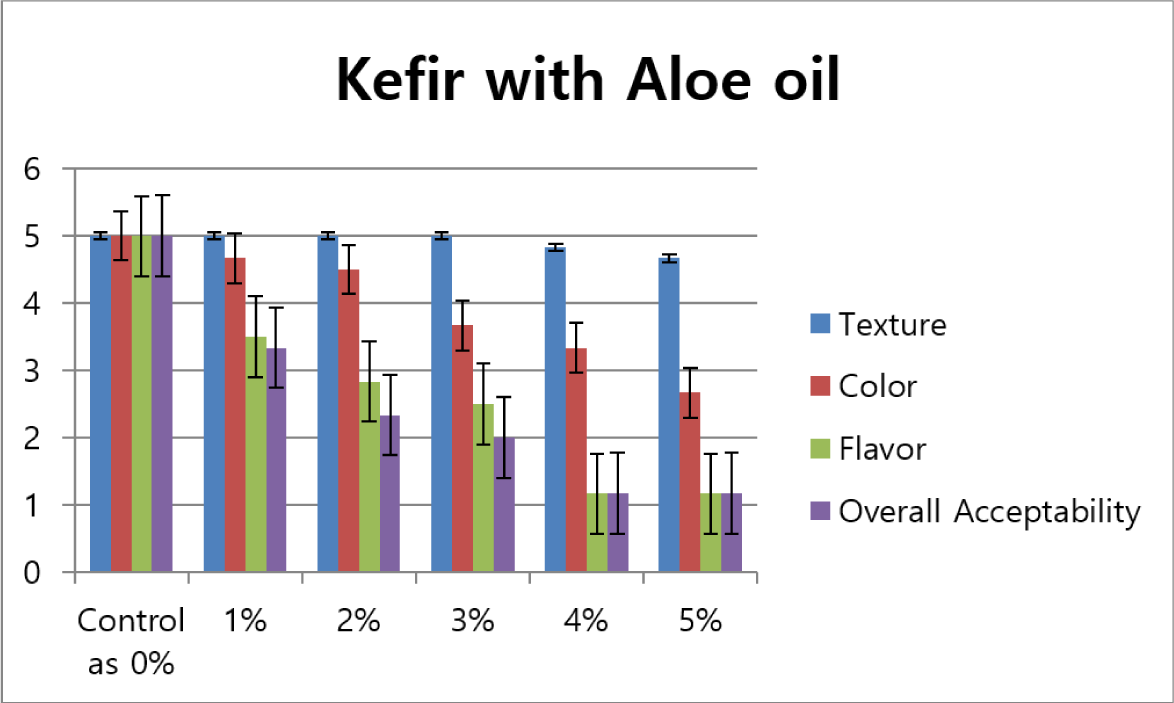
Based on the statistical estimation of the sensory quality of Kefir obtained in this study, the statistically significant difference was observed between the treated group and the control group in color, flavor, and overall acceptability except texture (p<0.05). When the addition amount of aloe oil was increased, the score of sensory quality of color, flavor, and overall acceptability tended to decrease except texture (Fig. 6). In this study, the Kefir added with 1% of aloe oil exhibited the best results compared with control group.
Also, Fig. 7 exhibited the process of color change in soy milk, cow milk, yoghurt, and Kefir fortified with diverse concentrations of aloe oil. In this study, soy milk, cow milk, yoghurt, and Kefir fortified with diverse concentrations (fortified by adding 1% increments from 0% up to 5%) of aloe oil were observed to change to a very strong yellow color (Fig. 7). Hence, in the sensory quality of soy milk, cow milk, yoghurt, and Kefir to which aloe oil was fortified, the score of color exhibited a tendency to decrease a lot (Fig. 3-6).
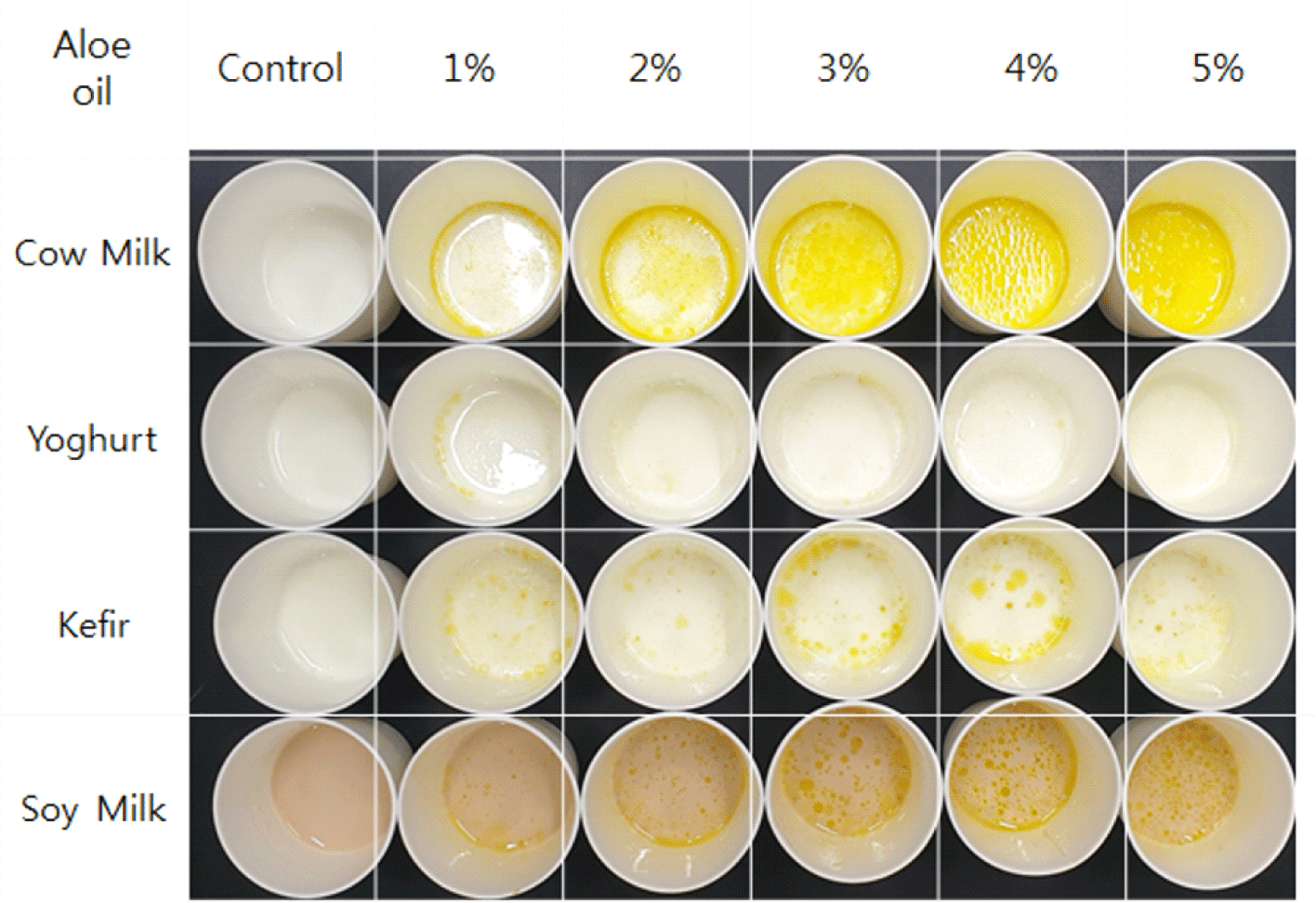
The contents of comparative review of the results of other previous studies similar to this study were summarized in detail below. After preparing fermented milk by adding A. vera gel powder, various effects during storage were investigated by Basannavar et al. [16]. The ACE inhibitory effect was significantly increased in fermented milk with A. vera gel powder (1% w/v) [16]. Since A. vera showed various functionalities that helped health, it was evaluated that it could be used as a food additive. And, Ikram et al. [17] investigated the characteristics of yogurt prepared by adding A. vera gel instead of milk fat. Yogurt with A. vera gel had a better texture and also showed high preference in consumer’s evaluations [17]. Especially, yogurt prepared by adding 3% A. vera gel to buffalo milk with 1% milk fat showed the best physicochemical and sensory quality [17]. This trend was similar to the sensory quality of yogurt and kefir, which belong to the fermented milk evaluated in this study. Next, 2 types of A. vera juice were prepared by fermentation of newly isolated Enterococcus faecium and commercially available Lactococcus lactis [18]. Most of the lactic acid was produced by using the added A. vera sugar as a carbon source for both lactic acid bacteria. Also, although antioxidant activity in A. vera juice showed a tendency to increase, the amounts of SCFA and total phenol was not affected during fermentation [18]. Therefore, A. vera not only had a variety of synergistic effects with probiotic lactic acid bacteria, but could also be a source of prebiotics, antioxidants and other bioactive materials [18]. For this reason, it could be evaluated that A. vera is suitable for the development of an A. vera drink with functionality because it provides many benefits to human health.
In conclusion, the sensory qualities obtained in this study are summarized as follows. Due to the strong aroma and strong yellow-color of aloe oil, when diverse concentrations were fortified to cow milk, yoghurt, and soymilk, the overall balance showed a tendency to be very poor. However, in the case of kefir, the characteristic flavor tends to be improved when the concentration of aloe oil fortified was low, but as the concentration of aloe oil fortified increased, the palatability tended to decrease due to the strong flavor of aloe oil. In other words, the characteristic grass (or herb) flavor and yellow strength of aloe oil were strong, so the scores of color and flavor were very low in the sensory quality. And above all, it is considered to be very valuable as the first study to estimate various sensory qualities by fortifying aloe oil to kefir.
In the future, when the added concentration of aloe oil is subdivided to less than 1%, first check the concentration with little difference in score from the control group in the sensory quality. Then, it is necessary to estimate the various biofunctional activities that aloe oil could exhibit at that concentration.
